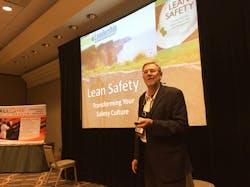For the uninitiated, lean can seem like a bit of a mystery. During a breakout session at EHS Today’s Safety Leadership Conference in Indianapolis, author and consultant Robert Hafey tried to clear up some of the more common misconceptions.
Lean isn’t a cost-saving program, Hafey explained, and lean isn’t a downsizing program. In fact, lean isn’t a program at all.
“It’s a philosophy,” Hafey said. “It’s a way of thinking. It’s how you see the world.”
Distilled to its essence, lean is about eliminating waste and making processes more efficient, with the goal of better serving the customer.
“Each process can be taken apart and improved endlessly,” Hafey said. “As a safety professional, you can take the same lean thinking and apply it to the processes that compose your safety program, and you can make safety a continuous-improvement activity.”
Applied to safety, the lean approach builds trust and fosters employee engagement, because employees are empowered to look for ways to make their jobs safer and easier.
“You’re intentionally creating a continuous-improvement safety culture where everyone is engaged in trying to improve safety, where the people who work in the shop believe that they own the safety program,” Hafey said.
More from Robert Hafey: "How Lean Can Drive Employee Safety Engagement"
Because lean is a “trust-building journey,” it can serve as an antidote to the “safety police” dynamic.
“If you’re continuing to push safety compliance, and you don’t get into the continuous improvement of safety where people see you as a valuable resource, it’s not a very nice place to be, because you're seen as the safety police,” Hafey said. “I’ve been in plants where [workers] use secret whistles and hand signals when the safety manager comes in the building. That’s not a good feeling.”
Doing vs. Wishing
Perhaps one of the reasons that lean can seem so mysterious is that it uses a number of Japanese terms to describe its key concepts. Two of the more common lean terms are “gemba” and “kaizen,” which Hafey explained to attendees:
- Gemba walk – “Gemba” is the shop floor, or the place where the work gets done. “In a lean safety gemba walk, we go out and watch people work, and we engage them in conversations about their work and ask them for their ideas,” Hafey explained. “Then we make their work safer and easier.”
- Safety kaizen blitz – “Kaizen” means continuous improvement, and blitz means “do it quickly.” In a safety kaizen blitz, a facilitator leads a small group of workers in a brainstorming session, with a specific improvement goal in mind (for example, to reduce the number of a soft-tissue injuries in a work cell).
“For a company starting the lean journey, the easiest entry point is safety,” Hafey said. “If you start focusing on making work safer and easier, you start building trust, and lean is based on trust. So safety is the easiest entry point, because management will support it, the unions will support it, frontline supervisors will support it – everybody will support it.”
For those who might be skeptical about gaining union buy-in, Hafey noted that on the first day of one of his lean safety workshops, union members showed up in their UAW T-shirts, “sending a bit of a message to me.” He then showed a slide quoting one of the UAW members after the workshop. In the slide, the UAW member said: “Lean safety teaches engagement and doing versus talking, planning and wishing.”
